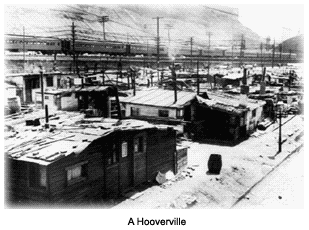Hoo•ver•ville - n.
A crudely built camp put up usually on the edge of a town to house the dispossessed and destitute during the depression of the 1930s.
- Dictionary of the English Language, Fourth Edition.
The stock market crash in October 1929, deepened a devastating depression that had affected the nation for nearly a decade. Many people used whatever means they had at their disposal for survival.
Hoovervilles
In the 1930s, Hoovervilles (shantytowns) formed coast to coast in cities of the United States. Some families were fortunate enough to stay with friends and family members that hadn't been evicted yet, but homeless men, women and children were forced to take up residence in shacks as a result of the Great Depression. Angry, cold and hungry Americans, who had no other place to reside, dubbed groups of those shacks in honor of President Herbert Hoover.
Those desperate folks blamed Hoover for the downfall of economic stability and lack of government help. The small amount of resources that the federal government actually made available often did not go to the sick, hungry and homeless. That was simply because many city officials were corrupt, and kept those valuable resources to themselves.
 Home sweet home
One of the largest Hoovervilles lay in the center of New York's Central Park. The Midwest and West Coast regions of the U.S. also were devastated by the depression. "Squatters' shacks" and rickety structures popped up everywhere. The depression affected the poor so much that they felt nothing but hopelessness.
Like human pack rats, ordinary people were forced to carry, wheel and drag bits of lumber, tin, cardboard, tar paper, glass, composition roofing, canvas, and other materials to the sites of America's new real estate boom.
Some fortunate men were skilled in carpentry, and were capable of constructing fairly solid structures, while others less skilled scraped together packing boxes and other discarded items to provide shelter. Unemployed masons salvaged stone blocks and old bricks to create 20-foot tall shanties. However, more unfortunate men were reduced to sheltering themselves inside empty water mains.
Hoovervilles and the economy
As the economic crash of the 1930s dragged on, more and more people were ruined. Delinquent taxes, drastically rising unemployment and mortgage foreclosures were heavy burdens to overcome. Those factors forced ordinary people to either move into Hoovervilles or become transients. Between 1929 and 1933, more than 100,000 businesses failed across the nation. When President Hoover left office in 1933, national unemployment hovered at a staggering 13 million — nearly 25 percent of America's work force.
Getting rid of Hoovervilles was a difficult task; people had no other place to call home. Several attempts were made to eliminate those small villages during the 1930s, but government and city officials couldn't really do anything about the health issues and scattered mess that Hoovervilles created.
Although most American cities participated in several New Deal programs, much of the country's political leadership was not enthusiastic about most federal initiatives. Many city officials fought local efforts to establish a city housing authority in 1938, arguing that public housing would depress property values, and was susceptible to Communist influence.
Some of the larger shantytown populations were organized; having their own mayor, sanitary committee and other committees. Finally, in 1941, a shack elimination program was put into effect, and shantytowns were torn down. Employment levels had begun to rise, which gradually provided some shelter and security for formerly homeless Americans.
Home sweet home
One of the largest Hoovervilles lay in the center of New York's Central Park. The Midwest and West Coast regions of the U.S. also were devastated by the depression. "Squatters' shacks" and rickety structures popped up everywhere. The depression affected the poor so much that they felt nothing but hopelessness.
Like human pack rats, ordinary people were forced to carry, wheel and drag bits of lumber, tin, cardboard, tar paper, glass, composition roofing, canvas, and other materials to the sites of America's new real estate boom.
Some fortunate men were skilled in carpentry, and were capable of constructing fairly solid structures, while others less skilled scraped together packing boxes and other discarded items to provide shelter. Unemployed masons salvaged stone blocks and old bricks to create 20-foot tall shanties. However, more unfortunate men were reduced to sheltering themselves inside empty water mains.
Hoovervilles and the economy
As the economic crash of the 1930s dragged on, more and more people were ruined. Delinquent taxes, drastically rising unemployment and mortgage foreclosures were heavy burdens to overcome. Those factors forced ordinary people to either move into Hoovervilles or become transients. Between 1929 and 1933, more than 100,000 businesses failed across the nation. When President Hoover left office in 1933, national unemployment hovered at a staggering 13 million — nearly 25 percent of America's work force.
Getting rid of Hoovervilles was a difficult task; people had no other place to call home. Several attempts were made to eliminate those small villages during the 1930s, but government and city officials couldn't really do anything about the health issues and scattered mess that Hoovervilles created.
Although most American cities participated in several New Deal programs, much of the country's political leadership was not enthusiastic about most federal initiatives. Many city officials fought local efforts to establish a city housing authority in 1938, arguing that public housing would depress property values, and was susceptible to Communist influence.
Some of the larger shantytown populations were organized; having their own mayor, sanitary committee and other committees. Finally, in 1941, a shack elimination program was put into effect, and shantytowns were torn down. Employment levels had begun to rise, which gradually provided some shelter and security for formerly homeless Americans.